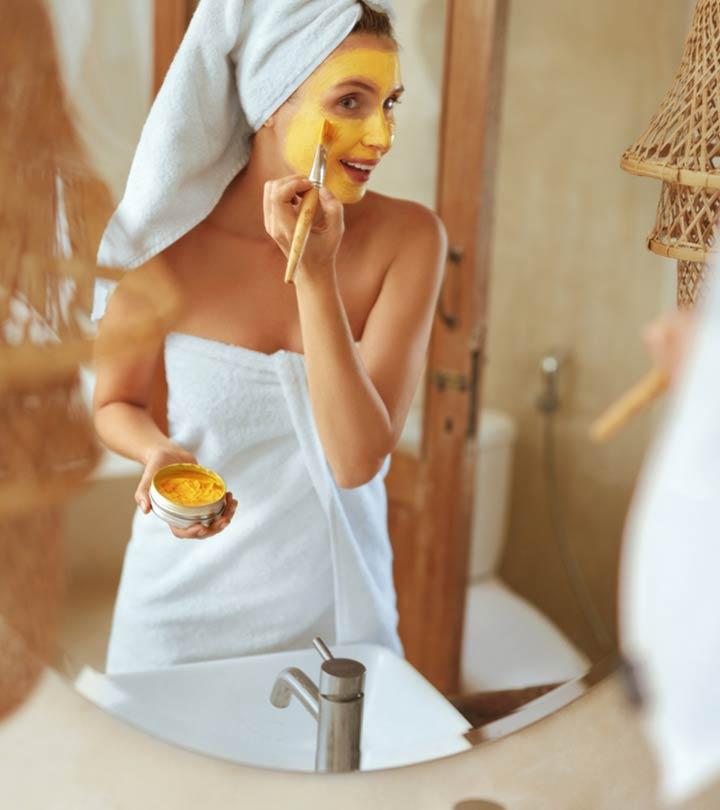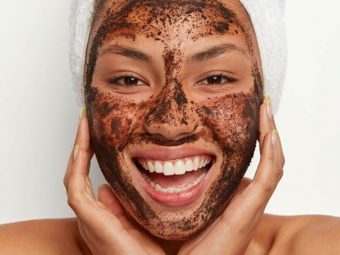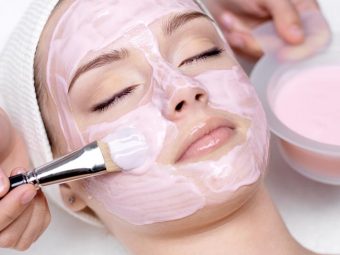Turmeric Face Pack: Benefits And How To Use
Enhance your skincare regimen with the spice's antimicrobial and antioxidant properties.

Turmeric is a common food colorant that has been used in India for centuries. Besides, turmeric is a popular ingredient that plays a key role in daily skin care. The benefits of turmeric face packs include fighting acne and keeping your skin radiant. But if you are unsure about making one, you have come to the right place. Read this article to learn about its potential benefits and the tips to keep in mind while using turmeric face packs.
In This Article
Is Turmeric Good For Skin?
Since ancient times, Indians have been using turmeric for their dietary and cosmetic purposes. Turmeric offers various benefits. In addition to using turmeric as a raw ingredient in a skincare routine, many skin care products also include it as their core ingredient.
The reason turmeric is so favored by many as a good skincare ingredient is its characteristic compound called curcumin. This compound possesses important anti-inflammatory and antioxidant properties (1).
In the next section, we have discussed the benefits turmeric can offer for your skin.
Benefits Of Using Turmeric On Face
1. May Boost Natural Skin Glow
Turmeric possesses strong antioxidant and anti-inflammatory properties. It is believed the spice may boost skin glow (2).
2. May Stop Facial Hair Growth
Some research suggests that turmeric may result in the breakdown of hair follicles on the face, thereby stunting facial growth (3). However, more research is warranted in this regard. Though using turmeric for removing facial hair may not be as effective as waxing or shaving, it sure could be safer and less harsh.
3. May Help Treat Psoriasis
In mouse studies, curcumin was found to help treat psoriasis (4). This may be the result of curcumins strong antioxidant and anti-inflammatory properties.
4. May Help Treat Acne
The antiseptic, anti-inflammatory, and antioxidant properties of turmeric may help treat acne (5).
5. May Offer UV Protection
The antioxidant properties of turmeric may help treat sunburns and also offer protection against the harmful UV rays, exposure to which may cause cancer, wrinkles, and hyperpigmentation (6).
In the next section, we will look at how you can make a turmeric face packs at home.
How To Make Turmeric Face Packs At Home?
1. Gram Flour, Sandalwood, And Turmeric Pack
Gram flour is believed to be a good exfoliant that may help remove dead skin cells from your face. Sandalwood (and its oil) may help protect against skin cancer (7).
What You Will Need
- 2 teaspoons of gram flour
- A pinch of turmeric
- 1 teaspoon of sandalwood
What You Have To Do
- Mix the ingredients in a bowl. Add some water to get a fine paste.
- Apply the paste all over your face and neck.
- Leave it on your face for 15 minutes and wash with lukewarm water.
How Often You Should Do This
Do it twice a week.
2. Milk, Almond, And Turmeric Pack
Anecdotal evidence suggests that milk helps slow down the signs of aging. Meanwhile, almonds are known for skin rejuvenating benefits (8).
What You Will Need
- 1 teaspoon of milk
- 1 teaspoon of almond powder
- A pinch of turmeric powder
What You Have To Do
- Mix the ingredients in a bowl.
- Apply it evenly all over your face and neck.
- Leave the mask on for 15 to 20 minutes.
- Wash your face with lukewarm water after 20 minutes.
How Often You Should Do This
Do this once a week.
3. Yogurt And Turmeric Pack
The lactic acid in yogurt may exfoliate the skin (9). Yogurt, along with turmeric, may also enhance ones complexion.
What You Will Need
- 2 teaspoons of yogurt
- 1 teaspoon of fullers earth
- 2 teaspoon of rose water
- ½ a spoon of turmeric powder
What You Have To Do
- Mix the ingredients in a bowl until you get a fine paste.
- Apply the paste evenly all over your face and neck.
- Leave the mask on for 15 minutes and rinse with lukewarm water.
How Often Should You Do This
Do this once a week.
4. Aloe Vera And Turmeric Pack
Aloe vera has antioxidant properties (10). These may enhance skin health and protect it from environmental aggressors.
What You Need
- 2 teaspoons of fullers earth
- 1 teaspoon of yogurt
- ½ a teaspoon of aloe vera gel
- A pinch of turmeric powder
What You Have To Do
- Mix the ingredients to form a smooth paste.
- Apply the pack all over your face and leave it on for 20 minutes.
- Rinse your face with cool water.
- Alternately, you can also use the aloe vera gel available on the market. However, fresh gel is way better than commercially packaged products.
How Often Should You Do This
Do this twice a week.
5. Turmeric, Cornstarch, And Honey Pack
Honey is a natural antioxidant (11). Some believe it may also make the skin glow. Cornstarch works as a binding agent and keeps the mask in place.
What You Will Need
- ¼ teaspoon of turmeric powder
- 1 teaspoon of honey
- 2 tablespoons of cornstarch
What You Have To Do
- Mix all the ingredients in a bowl and add water to make a fine paste.
- Apply the paste evenly all over your face and neck.
- Leave the mask on for 15 to 20 minutes.
- Remove the mask with lukewarm water.
How Often Should You Do This
Do this once a week.
6. The Ultimate Turmeric Facepack For Radiant Skin
This face pack is the holy grail of face packs. It contains everything that could make your skin glow and feel fresh.
What You Will Need
- ¼ teaspoon of turmeric powder
- ½ a teaspoon of almond oil
- 2 teaspoons of honey
- 1 teaspoon of aloe vera gel
- 1 teaspoon of yogurt
- 1 teaspoon of rose water
- Powdered oats or gram flour
What You Have To Do
- Mix all the ingredients in a bowl.
- Apply the pack over the face and neck. Leave it on for 20 minutes.
- Remove it with a warm cloth and splash cold water on your face.
How Often Should You Do This
Do this once a month.
While there are no known side effects of using turmeric on your face, you need to keep some points in mind.
Precautions To Be Taken While Applying Turmeric Face Packs
- Make sure to use turmeric in little quantities and only a few times a week. Turmeric may stain your skin and turn it yellow.
- Use fresh ingredients to achieve optimum results.
- Keep an eye out for the amount of lemon juice you use. Excess lemon juice may sting your skin and dry it out.
Turmeric’s antioxidant and anti-inflammatory properties help treat several skin care issues. It has been used as a home remedy for ages. Using turmeric may help fade dark spots, brighten your skin, offer UV protection, minimize acne, reduce psoriasis symptoms, and may stop facial hair growth. You may use turmeric face packs to reap the maximum benefits of the ingredients. Following the skin care routine discussed above will help you prepare a face pack in the comfort of your home. You will start seeing results in some weeks.
Frequently Asked Questions
Can we apply turmeric directly on the face?
When used by itself, turmeric may stain your face yellow. Do a patch test before applying turmeric to your face, especially if you have sensitive skin. If you notice any adverse reactions like tingling, redness, or irritation, wash off the turmeric immediately.
Can turmeric remove dark spots?
Turmeric may reduce hyperpigmentation, which may reduce dark spots. However, there is not enough scientific evidence to prove this claim.
Can I use a turmeric mask every day?
Using a turmeric mask daily may leave your skin dried out and stained yellow. It is best to use this mask only as recommended.
Does turmeric darken the face?
Due to its yellow pigment, turmeric may stain your skin. But it does not darken your skin.
Why is my face burning after applying turmeric?
This may be an allergic reaction to turmeric. If your skin is burning, wash off the turmeric immediately and consult a doctor. You should perform a patch test on your forearm before applying turmeric to your face to avoid adverse reactions.
Can turmeric cause pimples?
No. Due to its antibacterial and anti-inflammatory properties, turmeric actually helps manage and reduce pimples.
Can you sleep with turmeric on your face?
You may want to avoid leaving turmeric on your face overnight as it can stain your skin, clothes, and bedding yellow.
How long does it take for turmeric to work on skin?
If you use it consistently, you can see improvements in your skin texture, appearance, feel, and health in a few weeks.
Key Takeaways
- The curcumin in turmeric makes it an important ingredient in skin care products.
- It may boost the natural glow of your skin, offer UV protection, reduce acne, and stop facial hair growth.
- You can prepare turmeric face packs by mixing it with other natural ingredients like yogurt, almond oil, honey, etc.
- It is best to use turmeric in little quantities as it may stain your skin.
Recommended Articles
- 15 Effective Ayurvedic Face Packs For Glowing Skin
- 11 Best Face Packs For Skin Lightening
- 10 Effective Homemade Face Packs To Treat Dark Spots
- Curd For Face: What It Does For Your Skin And How To Use It
Sources
Articles on StyleCraze are backed by verified information from peer-reviewed and academic research papers, reputed organizations, research institutions, and medical associations to ensure accuracy and relevance. Read our editorial policy to learn more.
- Antioxidant and anti-inflammatory properties of curcumin
https://link.springer.com/chapter/10.1007/978-0-387-46401-5_3 - Turmeric, the Golden Spice
https://www.ncbi.nlm.nih.gov/books/NBK92752/ - Composition and Methods for Permanent Hair Removal
https://pubchem.ncbi.nlm.nih.gov/patent/US2014044814 - Curcumin shows excellent therapeutic effect on psoriasis in mouse model
https://www.sciencedirect.com/science/article/abs/pii/S0300908416000390 - Potential of Curcumin in Skin Disorders
https://www.ncbi.nlm.nih.gov/pmc/articles/PMC6770633/ - Protective effect of curcumin against ultraviolet A irradiation-induced photoaging in human dermal fibroblasts
https://www.ncbi.nlm.nih.gov/pmc/articles/PMC5928684/ - Re-discovering Sandalwood: Beyond Beauty and Fragrance
https://www.ncbi.nlm.nih.gov/pmc/articles/PMC6536050/ - The uses and properties of almond oil
https://www.sciencedirect.com/science/article/abs/pii/S1744388109000772 - Lactic acid applications in pharmaceutical and cosmeceutical industries
https://www.researchgate.net/profile/Azzam-Aladdin/publication/292990722_Lactic_acid_applications_in_pharmaceutical_and_cosmeceutical_industries/links/56b4a1b008ae922e6c02042d/Lactic-acid-applications-in-pharmaceutical-and-cosmeceutical-industries.pdf - Antibacterial activities and antioxidant capacity of Aloe vera
https://link.springer.com/article/10.1186/2191-2858-3-5 - Honey: A Novel Antioxidant
https://www.mdpi.com/1420-3049/17/4/4400










